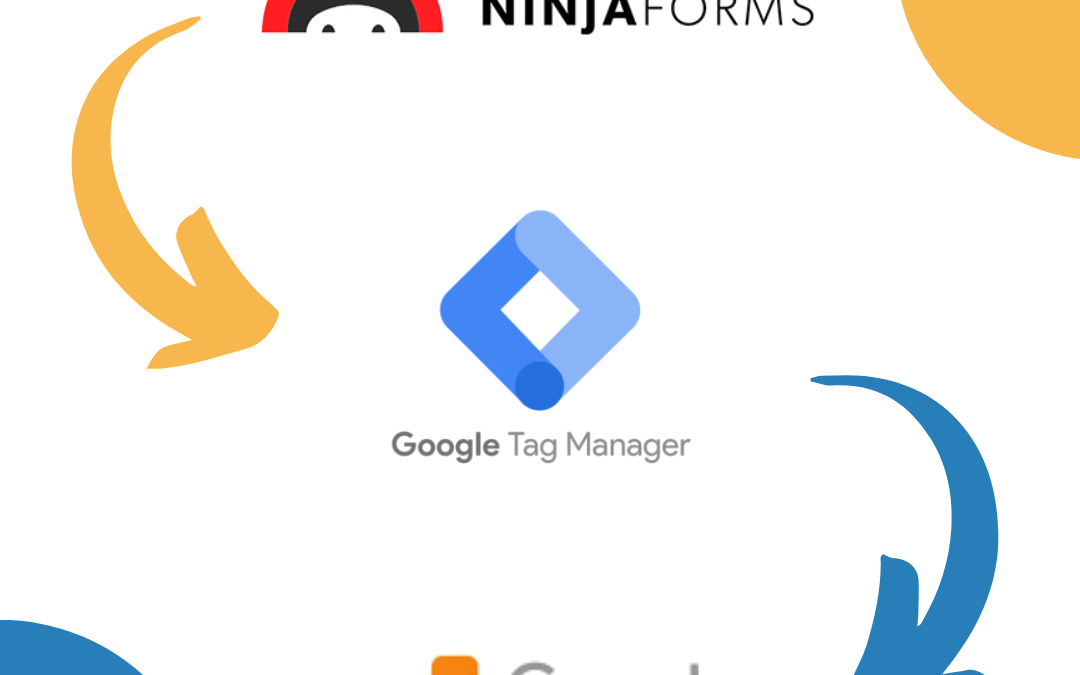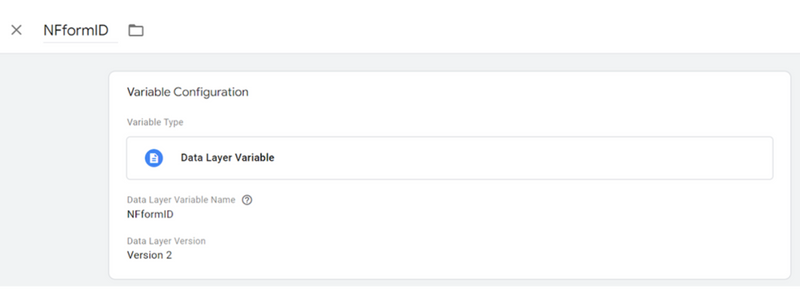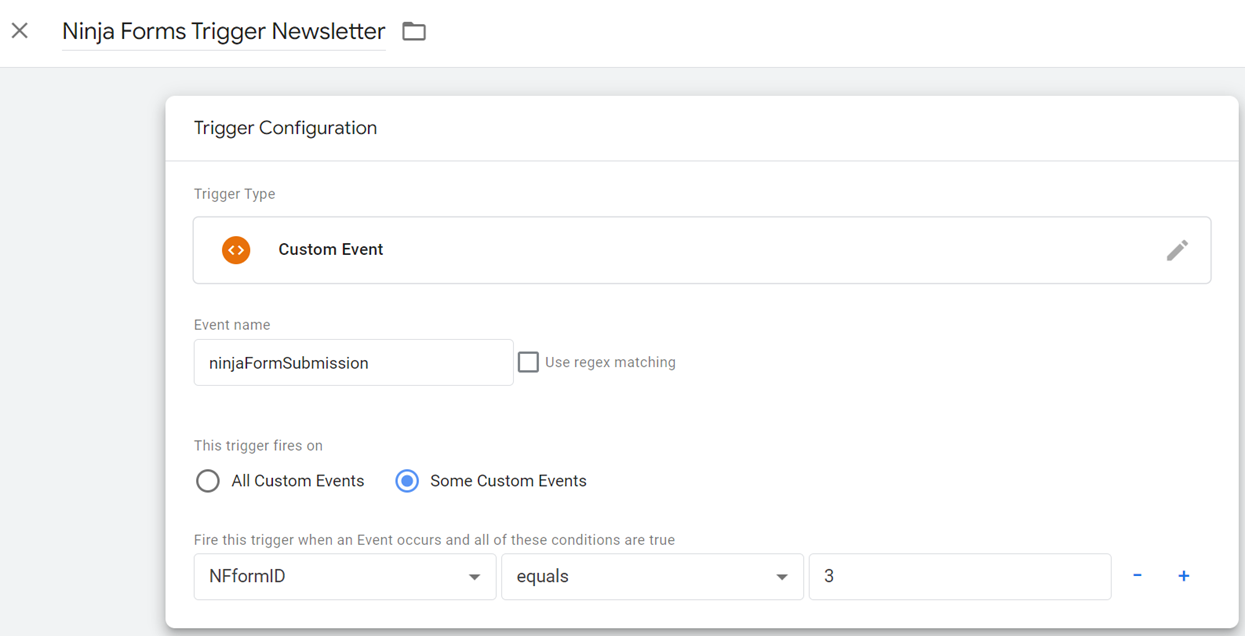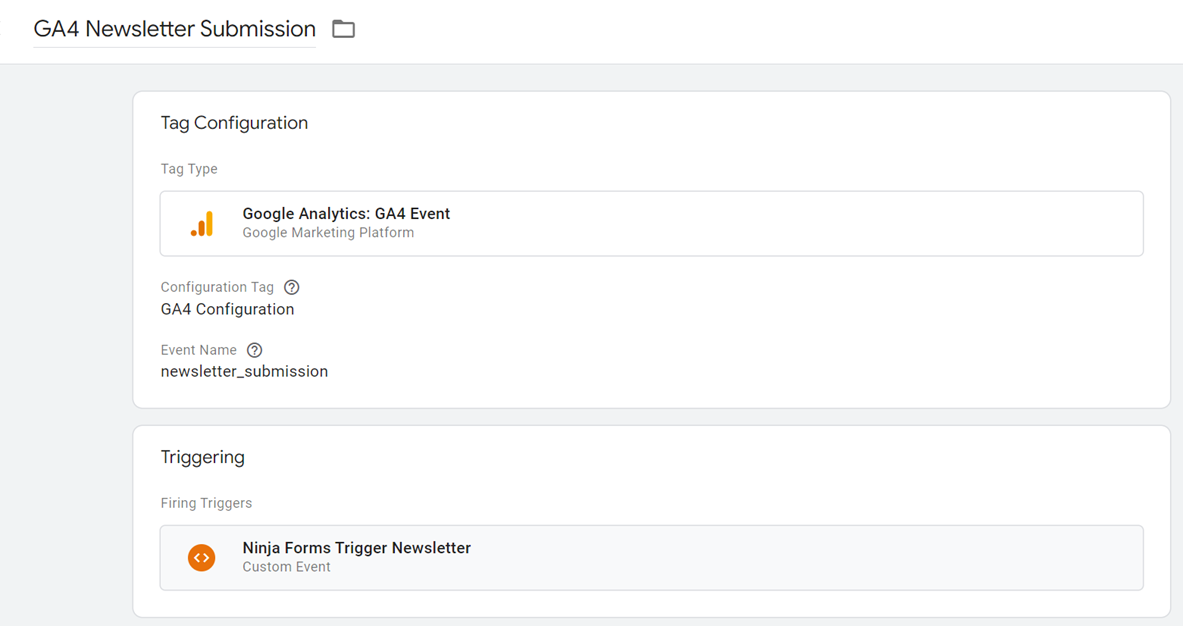
by Denae Luna | Nov 4, 2022 | Digital Marketing
Your website is the hub for your clients’ business interactions; tracking those transactions is imperative for understanding what works and what doesn’t.
Ninja Forms is a plug-in frequently lauded on WordPress sites for its easy-to-use platform, but like any form plug-in, it’s difficult to notify Google Analytics when a client completes a form through Google Tag Manager. When using Ninja Forms and Google Analytics 4 (GA4), we need to track when the forms are submitted and not just when the buttons are pressed.
This step-by-step guide will help you set up your Google Tag Manager to fire tags only when your forms have been submitted, and even better, you can set up separate tags for each form.
Step 1: Create a Tag to Listen for a Form Submission Event
Now this will require a bit of code, but I have that here for you.
- Start a new tag in the tag manager by going to Tags > New > Tags Configuration > Custom HTML.
- Copy/Paste this script into the tag.
<script>
jQuery(document).ready( function() {
jQuery(document).on('nfFormSubmitResponse', function(event, response, id) {
dataLayer.push ({
'event' : 'ninjaFormSubmission',
'NFformID' : response.id
});
});
});
</script>
- Next you need to go to Triggering and have the tag fire on All Pages so that it can listen for a ninja form no matter where the user is on the site.
- Last, you’ll need to name the tag something that you are going to use later. So here I’ve named mine: ninjaFormSubmission
It should look like this when you’re done:

Step 2: Create data layer variable for the Form ID
Because we need to differentiate between which form is being submitted, we will need to create a variable in Google Tag Manager that will read the the ID from the code we just created.
- Go to Variables > User Defined Variables > New > Variable Configuration > Data Layer Variable and name it NFformID to keep it consistent.
- Leave the version as is and hit Save.
It should look like this when you’re done:

Step 3: Create a Trigger that Fires on the event we created in Step 1
This step will let you create a trigger that fires when someone submits a form, but we are going to add a stipulation so that it only fires on the form you want it to. So each trigger is form specific. IMPORTANT: You will need to repeat this step for each form.
- Go to Triggers > New > Trigger Configuration > Custom Event and we are going to add into the Event Name the name of the event we created in Step 1: ninjaFormSubmission
- Then you are going to select Some Custom Events and we are going to use the name of variable we created in Step 2 from the dropdown: NFformID. Change the middle to “equals” then in the last column you’ll need to enter the number of the id of the form you want to track. This is found in WordPress on your Ninja Forms Plugin Dashboard.
It should look like this when you’re done (with the number being your own corresponding form id):

Step 4: Create a Tag that fires on the trigger we created in Step 3
So for every trigger you created, you’ll need to create a tag. This will be how you send GA4 your event data.
- Go to Tags > New > Tags Configuration > Google Analytics: GA4 Event. Use your configuration tag that you have set up for GA4 from the drop down.
- Name your event however you would like it to show up in GA4 for as an event for later. Depending on which form you are creating a tag for, I would name it respectively.
- Next go to Triggering Configuration and add the corresponding trigger for that form that you created in Step 3.
It should look close to this when you’re done:

Step 5: Getting your results out of Google Analytics 4 (GA4)
We’ve set all of the back end up so that now we wait. GA4 is set up so that events don’t appear on your events list until they are triggered. This could be a while depending on how much traffic you get on your site. And even when they are triggered, it takes about 24 hours for them to appear on your list.
- To view your events in GA4, you’ll need to choose Configure from the left navigation menu. These will be all of the events that have been triggered in the time frame at the top.
- Be sure that it has been at least 24 hours since you know that the event has been triggered to go looking for it. You can then mark any of these form submissions as a Conversion if that meets the needs of your business goals.
Tracking all of your business goals on your site can be cumbersome and difficult to manage. GA4 and Google Tag Manager work seamlessly to deliver you events to a place where you can analyze and act on how users are interacting with your site. Having all of that data information assists with measuring your KPIs and getting solid business lead data from your website all in one place.

by Emily Barnes | Aug 24, 2022 | Digital Marketing
Most internal marketing organizations have a scale issue. It doesn’t matter if you’re a mom and pop or Fortune 500 brand. While the size and scope of your organization might be different, every company is facing three key issues:
Marketing has become highly technical and fragmented.
If you are a brand or agency you’re probably hit up several times a day from a new technology provider or advertising platform that will supposedly make your marketing more efficient, more effective, and/or improve your ROADs. Unfortunately, all of these platforms take resources to setup, manage, and use to their fullest potential.
The reality is just about every marketing department has a long list of platforms and none of them are setup and/or optimized to work efficiently. To make matters worse these platforms are rarely integrated. The technology we rely upon as marketers to make our lives easier is in many cases making our lives harder because it unintentionally is fragmenting our operations.
Difficulty hiring and retaining key talent.
This headline says it all here. Every industry seems to be facing a shortage of talent, but technical expertise is at a critical shortage. As marketing becomes more technical we find ourselves competing with other tech companies for talent. Finding people with experience on the platforms we rely on is hard enough and many organizations (especially SMBs) do not have the resources to hire an inexperienced employee and train them.
Challenges identifying, working with, and managing 3rd parties (agencies, consultants, and tech platforms).
Since it is difficult to hire and manage domain experts to service all aspects of a marketing tech stack most organizations look to outsource to agencies, consultants, or they allow their tech partner to manage their instance for them (for an additional fee). Unfortunately, the amount of experts you need is growing.
Advertising on just Google and Facebook/Instagram isn’t enough for most brands anymore. You need to be on TikTok, Snap, connected TV, streaming audio, native, and digital out-of-home. Add these unique channels to your CRM, CDP, email platform, SMS, content calendar…. (I’ll stop). It quickly becomes unmanageable to oversee best of breed 3rd parties to manage all of your platforms for you.
The end result of these issues is chaos and inefficiency. How can your organization take meaningful steps to address your scalability issues and make your marketing team more efficient?
Marketing Operations Leadership
A lot of marketing teams lack dedicated project management or operations managers who are dedicated to making sure everything runs like a well oiled machine. While it is difficult to hire anyone with specific domain/technical expertise it is easier to find good project/operations managers. You don’t even need a senior level hire for this role. Having someone on staff that is dedicated to the operations of your marketing department will pay major dividends. It will provide the flexibility you need to ensure your internal staff and 3rd party partners are in sync and operating efficiently saving significant time and money.
Balance 3rd party agencies/consultants between how much assistance they can provide to match your goals.
If you have marketing ops that can manage many 3rd parties then select best of breed, niche partners to service all of your needs from ad buying specific platforms like TikTok, to analytics/reporting, and more. If you’re a leaner marketing organization you need to identify your core needs and find partners that can provide support for multiple items. While domain experts are great, more often than not someone who has some experience across multiple disciplines can provide work that is good enough to significantly enhance your marketing efforts (basically you don’t always need someone with a ton of experience, the vast majority of orgs can get the job done with intermediate level expertise on most platforms).
Simplify your platform/tech stack.
This might sound similar to point #2, but this gets down to doing a good job of picking the right partner/platform. There are thousands of martech/adtech companies and I’m sure you have seen 10s if not 100s that could theoretically help your organization. I always challenge our clients to ask one of two questions:
Does this solution help us enough to take on the additional responsibilities to maximize the opportunity?
Does this advertising platform help us reach enough incremental new in-market consumers to take on managing it?
The bottom line is looking at the incrementality of a solution. Any time you add a solution to your stack it requires resources to manage and make it work properly. The new solution must provide a lot of value to justify adding resources to manage it.

by Emily Barnes | Aug 9, 2022 | Digital Marketing
While there is no “easy button” in marketing, here are two things you can kick off today that can give a boost to your digital marketing efforts.
Test A New Platform
The digital media landscape is changing. More people are spending time online across a more diverse range of content. Whether you want to diversify your paid, earned, or owned media there are several new platforms to try. The key here is to pick one platform, perfect it, and move on to another.
One mistake we see organizations routinely make is trying to be everywhere all at once. This creates a haphazard user experience and ultimately fails to resonate with your target audience. We strongly suggest getting really good at one platform first. Do not move on to another platform until you feel like you have maximized your knowledge of how to optimize it.
Organic Cross-Promotion
Find opportunities to plug all of your communications channels/social platforms so your audience knows where to find you. When you embed a video into email communication make sure it links to your YouTube page. If you are active on Tiktok use your video content generated on the platform on Instagram, Facebook, and YouTube. Invite followers on social media to join your email list. The options are endless!
The bottom line is that you remain consistent with your cross-promotion. Whether you used paid, earned, or owned tactics to acquire your audience, make sure they follow you on as many channels as possible. Organic reach is limited on every platform so the more opportunities you have to reach the same person with organic content the more likely they are to see it!

by Emily Barnes | Jul 29, 2022 | Digital Marketing
Let’s talk about building an online community… Since the dawn of the digital era building, a high-quality email list has been the foundation of any marketing strategy. Not only does the ROI from email beat every other channel, but the email address has also become the gold standard in cross-channel audience targeting. That said, competition for attention in the inbox is at all-time highs (and will continue to get harder).
It is time for marketers to take a more holistic approach to their audience engagement. Your audience spends a lot of time on multiple digital platforms consuming content in myriad ways. Here are some places you should build community:
TikTok
TikTok has found a niche to provide people an easy way to produce, share, and discover short form user-generated video content. TikTok also isn’t just for young kids anymore. The 28-50 demographic is rapidly growing. Like it or not, TikTok has made it easy for user-generated video content to go viral, opening up affordable opportunities for individuals, brands, and organizations of all types to get into video promotion.
In fact, we are seeing the adoption of user-generated video content from TikTok get applied to other video formats including Facebook, Instagram, YouTube, and even Connected TV. If you haven’t invested in a video strategy due to cost constraints now is the time to get in on the user-generated video content craze. All it takes is a little time and a cell phone to create a short video that connects with your target audience.
YouTube
YouTube reached a whopping 81% of the connected audience in the US every month. Usage is strong across every demographic and being within the Google ecosystem targeting is second to none. Using paid promotion to get key video messages in front of target audiences using an email list, contextual targeting, or even an affinity audience provided by Google is a scalable strategy for any marketing strategy.
Meta Platforms
Facebook and Instagram are dynamic duos that can be managed using Meta’s Business Manager. The tools available for managing and analyzing brand owners’ accounts are generally easy to use so even marketing beginners can pick up the basics. The combined reach of Facebook and Instagram across all demographics plus a wide variety of content types (video and static post types) gives you a lot of options to engage your audience.
Twitter
Twitter is an often forgotten social media platform, but it is a powerful tool to reach audiences looking to consume small snippets of content at a time. Many communities have emerged on the platform. You can pretty easily identify key influencers and topics that are pertinent to your organization with a keyword or hashtag search. organic content on the platform. It doesn’t take very much time and you will be surprised by who is out there listening. A few minutes per day on Twitter could unlock your next big customer/partnership/advocate or even make your organization go viral.
LinkedIn
LinkedIn is the place to be if you’re targeting business professionals. The reach and targeting options for ads are second to none in B2B. While it can be expensive to run targeted ads to boost your reach there are ways to get organic content amplified. Target partners, brand champions, or key allies on the platform and ask them to share your content with their connections. It is a tried and true method for driving awareness of your message.
When you have multiple touch points with your target audience you will increase your overall organic reach and ensure no important communication is missed. Be sure to follow Population Science for more content on how to build your omnichannel community online!

by Emily Barnes | May 11, 2022 | Digital Marketing
Your website is a pivotal asset of your business. A quality website is organized, easy to navigate, and inspires customers to conduct business with you. From design and content to user experience, no matter your industry, a top-notch website is crucial to the success of your business. Your website design strategy needs to consider these top stats before undergoing the task of planning.
We’ve been sharing useful data in our Stats to Consider When Crafting Your Digital Strategy series. Previously we shared Social Media Marketing and Email Marking statistics. To keep helping you craft a high-quality digital strategy, here are 10 website statistics you need to know.
1. 94% of first impressions relate to your site’s web design
First impressions matter. You don’t want a potential customer to be turned off at first glance due to a poor design. Invest in a high-quality web design that is a reflection of your high-quality business.
2. 89% of consumers shop with a competitor after a poor user experience
It only takes one bad experience for a customer to swear off a business for good. Provide seamless online experience that keeps your customers on your site and in your corner.
3. 74% of users are more likely to return to mobile-friendly websites
We’ve said it before- optimizing for mobile is crucial to the success of your business. Customers are accessing information on their phones daily, so it is essential that your website fits their mobile needs. Bonus stat: In 2018, mobile ecommerce revenue accounted for 50%of total U.S. e-commerce revenue.
4. 47% of Users expect a maximum of 2 seconds loading time for an average website
Customer’s patience isn’t always high- and frustrated customers leads to abandonment. Don’t allow something like loading time turn customers away from your site.
5. Slow-loading websites lead to a $2.6 billion revenue loss each year
Customer abandonment has its repercussions. Investing in a website that prioritizes high speed loading times helps ensure your customers are satisfied with their digital journey.
6. Users spend 88% more time on pages with videos
The more time spent on your site, the more likely someone is to make a purchase. Video content can be used to grab users’ attention, provide information, and keep your customers engaged on your site.
7. 77% of agencies believe that a bad website User Experience is a weakness for their clients.
This statistic shows there’s major room for improvement when it comes to user experience. Poor user experience leaves customers confused and irritated, making it more likely for them to abandon your site. In turn, a stellar user experience builds trust and helps ensure there’s nothing standing in the way from creating long lasting support.
8. It takes 2.6 seconds for a user’s eyes to land on the area of a website that most influences their first impression
Your website design should be balanced. Consistency, cohesiveness, and functionality contribute to a quality website design. We recommended checking out industry leader’s website to gauge what web designs repeatedly perform well.
9. Users spend an average of 5.59 seconds looking at a website’s written content
Written content is important, but 5.59 seconds isn’t very long. It is crucial to provide your customers with the important information they need to know in a quick and concise way so they are getting the most out of their online experience.
10. 70% of small business websites lack a Call to Action (CTA) on their homepage
Providing a clear call to action on your homepage gives your customers the guidance to understand what it is you’re wanting them to do next. Call to actions inspire your customers to spend more time on your site, further conduct business, leading to overall success.
A quality website is at the core of a quality business. Invest in a website that tells your story, is well-designed, and is user friendly to set yourself and your customers to be as successful as possible.

by Emily Barnes | May 11, 2022 | Digital Marketing
The paid media landscape is always changing. While Google and Meta remain dominant, challengers such as TikTok and Amazon are rapidly taking market share. Brands are also getting into programmatic media buys to access new ways to engage audiences via connected TV, streaming audio, and digital out-of-home. No matter what your media mix looks like, here are four stats to keep in mind when developing your paid strategy in 2022:
- Mobile devices account for 69 percent of all clicks on Google Ads.
Digital marketers need a mobile-first strategy. Keep in mind that you have less real estate to engage audiences on mobile devices so plan your media placements, content, and landing pages accordingly.
- Mobile video ad spend will be around 72% of the digital ad spend in 2021. (G2, 2020)
Whether you are an avid YouTube watcher, streaming app user, or you’re into short form video from TikTok there are numerous options to consume video online. The mobile video experience differs depending on the platform users are leveraging so make sure your video content is optimized to the platform you’re running on.
- Voice search provides a ripe opportunity for PPC marketers, as voice-based ad revenues are slated to reach $19 billion by 2022.
Alexa and Siri have become household names and voice-activated platforms are actively finding ways to turn your voice searches into advertising opportunities. If you are finding keyword costs on Google or Bing are getting too rich for your budget you might want to look into less crowded opportunities in voice search.
- The average person sees 5,000 ads per day. (G2, 2020)
Do you recall every ad you see on a given day? Of course not. While media buyers can get into the weeds of data targeting we cannot underestimate the value of good creative. Even the most accurate audience targeting your campaign can still fail to produce with subpar creative.











